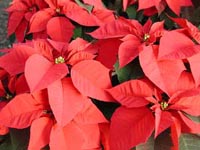Resource Library
Plant of the Week: Poinsettia, Freedom ('Freedom Red')
The University of Arkansas System Division of Agriculture does not promote, support or recommend plants featured in "Plant of the Week." Please consult your local Extension office for plants suitable for your region.
Plant of the Week
Freedom Poinsettia 'Freedom Red'
Latin: Euphorbia pulcherrima

With big bird safely tucked under our belts, it’s now time to raise our collective sights to the next holiday extravaganza, Christmas.
Poinsettias begin showing up in stores a week or two ahead of Thanksgiving, but the bulk of sales occur during the two weeks following the November holiday. While the majority of the 200 million or so plants sold each year are red, and the majority of these are a cultivar known as ‘Freedom Red’, other colors and foliage types are available.
In its natural habitat in southern Mexico, poinsettia (Euphorbia pulcherrima) grows as a small tree to 15 feet tall with fiery red blooms appearing naturally in December. It has been cultivated as a greenhouse crop since just after the Civil War, but it was not until after World War II that plant breeders began to do their magic and recreate the plant in its many-varied forms. In my trials in Fayetteville, I’m currently growing about 65 different cultivars, probably about half of the number currently available to the greenhouse trade.
The size of a potted poinsettia is primarily a function of time. Most growers plant their crop from late July to mid August. Flower buds initiate on this short day crop around the time of the autumn solstice, so any vegetative growth that the plants make has to be achieved before that date. The really large, shoulder-high plants you see in churches during the holiday season were started in May and used as mother plants for greenhouse growers propagating their own cuttings.
One of the most dramatic changes to occur in the poinsettia world has been the development of the self-branching habit of growth. Prior to 1960, poinsettias were grown as
unbranched plants with a large, terminal bract that could be 12 to 16 inches across. But with the introduction of the Hegg series in the early 1960s, pinched plants with five to seven blooms appeared. Pinched plants now dominate the market.
Branching is not a natural characteristic of poinsettias for the plant is blessed with strong apical dominance. Plants with strong apical dominance produce a hormone called auxin which diffuses from the terminal bud and suppresses the growth of axillary buds below it. But, it turns out there’s this disease.
The organism is a primitive disease known as a phytoplasma (mycoplasma) which, from an evolutionary standpoint, resides somewhere between a virus and a bacterium.
On the lethality scale, this disease organism is relatively benign, but it does interfere with hormone metabolism. The phytoplasma seems to produce a hormone that promotes growth of the axillary buds. The growth seen on some succulents and cacti is caused by a similar organism. When breeders develop a new poinsettia hybrids, they then graft this new plant onto an infected plant to intentionally inoculate the new selection with the branching organism.
I will be showing some of the newest poinsettia cultivars at two locations in early December. During the afternoon of Dec. 1 and 2 the display will be at Westwood Gardens on Highway 16-West in Fayetteville. From 1 p.m. to 4 p.m. on Dec. 4, the display can be seen at the state headquarters of the University of Arkansas Cooperative Extension Service at 2301 S. University Ave. in Little Rock.
By: Gerald Klingaman, retired
Extension Horticulturist - Ornamentals
Extension News - November 30, 1999
The University of Arkansas System Division of Agriculture does not maintain lists of retail outlets where these plants can be purchased. Please check your local nursery or other retail outlets to ask about the availability of these plants for your growing area.